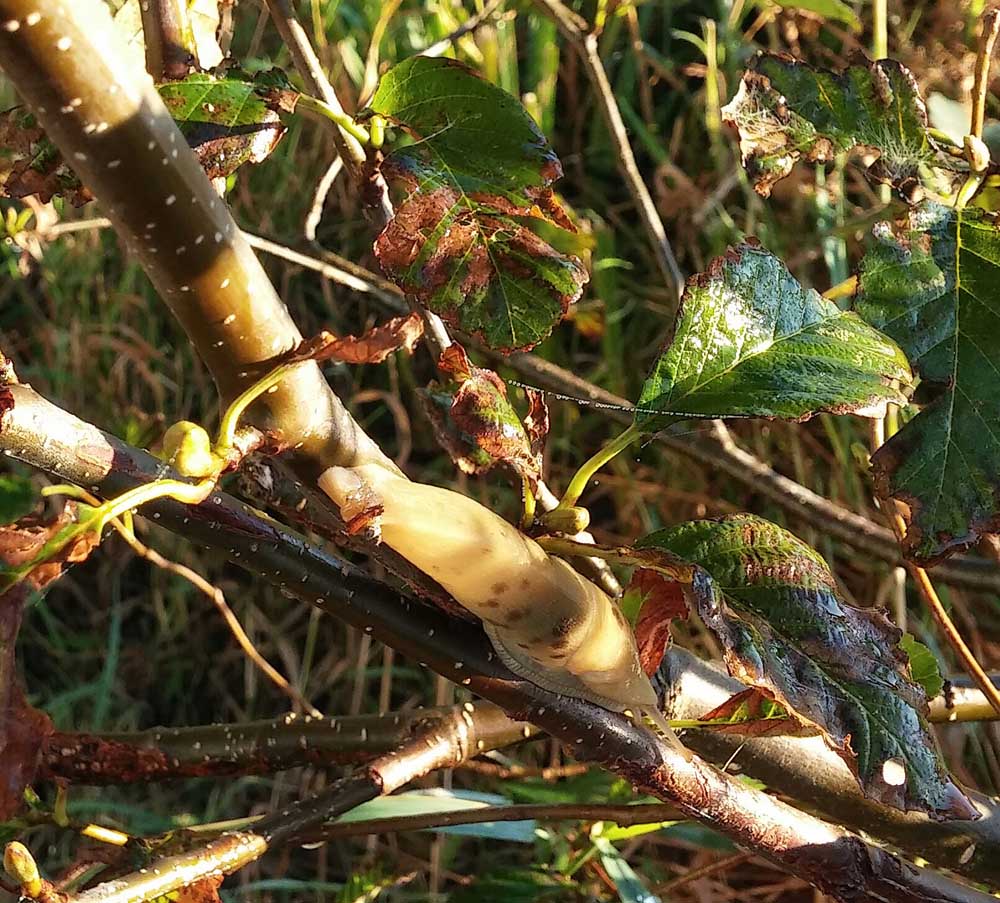Garden Mind Autumn-like temps bring transitions in local gardens
Published 9:04 am Tuesday, September 15, 2015

- A banana slug takes refuge five feet off ground on a tree branch.
In the past few weeks we’ve witnessed the end of a prolonged regional drought, the biggest summer storm in recorded history, a frightening season of fires that scorched thousands of acres of forests and grasslands, and an early return of snow to de-nuded mountain tops.
Trending
What this pattern meant for local gardeners was a bumper-crop year for tomatoes and peppers and hot-season crops. And many also saw parched lawns and potentially damaged landscapes; the bravest among us let our fescue lawns encounter heat dormancy, and now we get to witness the greening miracle that comes with rain: having to mow again.
The return of September’s cool night-time temperatures and rain may slow the garden, but your shrubby perennials and trees will recover their vigor now, and better withstand any cold extremes that may develop.
What is happening in your garden? If it’s like mine, that freak summer storm caused some “redecorating” in the yard. We had several big branches come down from the big black walnut tree, but there was no damage to the roof, although what a pile to clean up! Turns out this is a great time to assess all the plants in the landscape, and begin the fall clean-up early. (Gotta get out the chain saw before I can mow, for example.)
Trending
This past week the night temperatures have dropped to the 40s, low enough for the growth of annual plants to come to a halt. You may have noticed that at the same time your perennial plants began to flourish, as they re-nourish with the release of soil nutrients from the rains. What you witness is the start of recovery for stressed plants, with color and new growth returning. NOTE: Please resist the urge to fertilize summer-stressed plants, which may be hardening off for winter semi-dormancy. A stressed plant must recover before it can utilize additional chemical feeding; however the light application of organic fertilizer and mulches is recommended. (Resume a typical feeding regimen next spring.)
Sadly, many annual plants clock out for good with this advent of the fall triumvirate: declining daylight hours, lower night-time temperatures, and increased humidity. That said, it’s a good time to see what you can add to the garden, like semi-hardy plants, for extended color and garden performance.
A tiny shift from the vegetable patch to the landscape can increase your garden happiness quotient. Two or three colorful pansies by a frequently used path add cheer to the day. Two of my favorite late-summer flowering plants are the Japanese anemone (white and pink forms) and the hardy fuschias. Also, the fall bulbs are ready to plant, for a spring display of tulips, daffodils and more. My process is to clean a bed, plant bulbs and any small plants, then mulch fairly heavily. Try this and the garden work will be much easier come April and May.
A garden is a place to learn about process, an excellent primer on the way things start, grow, and finish. The best bonus is when you eat the fruits of your labors.
The lucky gardener who has time and resources to grow often discovers they must learn another skill-set too: how to put up crops, or to can or ferment produce to keep it longer in the pantry. Is this you? Whether you learn from an elder or utilize videos from on-line sites, or take an Extension class on safe canning practices, this is a great way to extend your food production.
When you put it up yourself, you’ll have a different perspective on the seed catalogs when they arrive in the cold days of winter, that’s for certain. Look for varieties specific to your new interests and tastes, and apply what you learned from your garden this year.
Consider other style of laying out your plot. For example, perennial plants need undisturbed beds to grow, so tilling the rectangle isn’t always the best answer for all you want to grow and eat.
Gardens require time, money, and some land (or pots) and access to water. Having access to a garden is a good way to learn about limitations; often the garden you plan in the darkness of February and March can lead to ambivalence later; as in when you get busy, when company comes, when the work piles up.
In the case of 2015, the year everything changed, we had ample sun and little rainfall. What did you learn? Did you have time to manage the weeding, staking, and watering? In fact, gardens can become a big hassle if you aren’t prepared.
The thing about a garden is this: it forgives. Congratulations if your garden grew well. Keep notes on what worked and tweak the process so it works for you. And while doing your clean-up, consider whether a bigger plot is in order for you, perhaps one where you “grow an extra row” to donate.
And give thought to where you’d put beds for perennial food plants: currants, rhubarb, cane berries and blueberries, artichokes, asparagus and more. In four years you will be happy you did.
What to Do Now:
1. Clean up. Try to evaluate the entire garden and landscape. Trim out dead and diseased plants. Sterilize pruning blades after cutting diseased tissue with a mild bleach solution (1 T. bleach to one gallon water; dip blades, wipe dry with rag). If discarded portions have disease, don’t compost these parts, but put directly into a garbage can.
2. Keep a journal and take notes. Use your cell phone to take pics to document “before and after.” And take pictures of spiders and slugs.
3. Enjoy yourself. If the garden was too much, scale it back. Make the process — and garden — work for you. (In my case, I must report I enjoy growing ornamentals more than the urgent demands of edibles.) Know what works for you.









